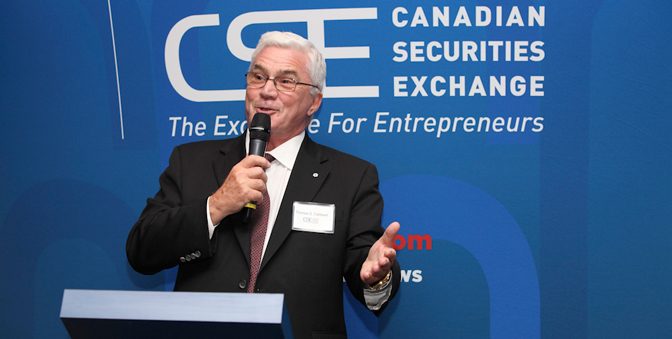
The first half of 2016 has been eventful for the CSE as well as for early-stage securities markets more broadly. With a return in trading activity and prices in the shares of early stage companies, investors are once again shifting focus back to growth stage firms.
While price action is one part of the story of any publicly listed entity, there are also other forces that influence the health, competitiveness and overall sustainability of the growth stage marketplace.
In a recent interview with Peter Murray of Kiyoi Communications, CEO of the CSE Richard Carleton discussed some of the milestone achievements at the Exchange for Entrepreneurs thus far in 2016, as well as his take on the forces shaping capital raising structures and participants.
Below is the transcript of their interview:
(PM) Earlier this year the Investment Industry Regulatory Organization of Canada (IIROC) requested written proposals for addressing market structure issues facing small-cap issuers. What were some of the important themes identified in the CSE’s response?
(RC) IIROC asked a variety of participants in the small capitalization space – exchanges, issuers, broker dealers and other stakeholders – to comment on, and propose potential solutions to, a number of specific issues raised over the last few years within the industry. This took place on a couple of levels, one being the technicalities of such things as short sale rules, tick size and board lots.
The CSE thought it was also important to look at the bigger picture and where the industry can go over the longer term to address what we think is a significant issue, which is a noticeable reduction in buyer interest.
When we look at what has happened to the junior capital space in Canada over the last five to seven years, the decline in commodity prices has clearly had a major influence. For certain, it has encouraged some investors to look at opportunities outside the small-cap space. But we think that the problems afflicting small-cap formation in Canada go beyond the decline in commodity prices.
Broad industry change is continuing to take place, a big one being the decline of the independent brokerage firms in Canada, and a rising concentration of assets under management at bank-owned dealers. The independent firms have long been an important part of the community helping to finance resource exploration, technology research and other forms of business development important to the Canadian economy.
What we see in the current environment, however, is that many of the independent firms have disappeared, with the remaining firms experiencing extreme pressure on their business models. These firms are an important source of retail investor interest in small-cap stocks through the support of their investment advisors, where a dealer will commit to an underwriting or participate in a dealer syndicate supporting an underwriting or capital raise. And in the secondary market they support trading through stock recommendations and research.
That model has broken down to a significant extent over the past five years and instead what we increasingly see is corporate finance being conducted through the exempt market. Speaking from the perspective of the CSE, we see about 90% of the money raised by our issuers coming from the exempt market.
So-called accredited investors are the primary source of capital in the exempt market. But accredited investors in Canada only represent about 1-2% of all households. This sharply narrows the number of investors eligible to participate in small-cap financings and, needless to say, limits the amount of money available for companies to raise.
The industry has adjusted to the decline of the independent broker by leaning more and more on the exempt market. But at the CSE, we are concerned that this is far from a complete answer to corporate finance challenges moving forward.
(PM) What do you see as some of the solutions to reinvigorating the early stage capital formation process in Canada?
(RC) One of the things we really need to do is engage the next generation of investors. The industry is not doing a good job of encouraging the next generation of investors to come into the Canadian equity markets. One approach to consider is providing a very clear set of guidelines for early stage crowdfunding. It is a potential source of modest amounts of money, say around $1 million to $1.5 million, but the funds can be acquired at relatively little cost to the companies raising the money.
The problem in Canada is that we have a fragmented regulatory regime with different sets of rules dictating how crowdfunded offerings can be marketed, depending on the residency of the potential investor. This makes it confusing for people to know if they can participate or to what extent they can participate in a given offering.
It also makes it difficult for those managing the websites that people use to find out about different investment opportunities to carry out compliance activity on a national basis. The whole process becomes complicated and the likelihood of making mistakes rises significantly. You have to decide between limiting an offering to a province or group of provinces that have the same rules, or taking on the compliance risk associated with doing a national offering across Canada.
That’s a real problem that adds cost, complexity and confusion for everyone involved.
The other issue is that once a company is beyond the crowdfunding stage, there really isn’t much other than the accredited investor exemption to help companies to raise funds.
The CSE is looking very carefully at new legislation in the United States that has come into force just recently under the JOBS (Jumpstart Our Business Startups) Act. The objective in that case was to provide a relatively simple means of raising equity capital from the public that eliminated the necessity of having to file a prospectus with the Securities and Exchange Commission (SEC) or become a reporting issuer with the SEC.
In the United States, companies will be permitted to raise up to $50 million per year and to market these offerings to individual investors subject to participation limits of $1,500 per opportunity and an aggregate of $10,000 per year for each investor. These rules are in place across the United States and require a relatively limited amount of work on behalf of an issuer. For companies on the CSE it would be a very cost effective means of raising capital from individual investors because our companies already meet most of the requirements to participate in such offerings. They file quarterly financial statements, their audits are subject to annual review, secondary trading is monitored by an independent third party, plus they have continuous disclosure requirements and are regularly providing updates to the investing public.
With all of those benefits available, CSE companies are positioned well to take advantage of such funding opportunities. In fact, we already have one company in the process of marketing an offering under the JOBS Act right now.
We would really like to see a similar mechanism put into place in Canada because it would provide a bridge between crowdfunding and full-blown prospectus-led offerings, which have to be reasonably large before the associated cost begins to make sense.
One of the key things to understand here is that instead of limiting participation to accredited investors – people with large investment portfolios or substantial annual incomes – the new rules actually present the opportunity to engage a whole new generation of investors in the equity market. And really it is that generation that we have to bring into the market in order to provide a successful and healthy ecosystem for capital formation in the coming 15-20 years.
When I go to industry events, I am often surprised at the average age of people in attendance. The average is quite high and that is not a sign of an industry positioned to continue supporting the needs of growing enterprise in Canada for the next generation. We need more young people engaged and we feel that a clear-cut means of permitting them to invest in companies directly and trade the shares afterward is very important.
(PM) What specifically is the CSE doing to help ensure this new environment is fostered?
(RC) I think one of the challenges we have in Canada is the fragmented regulatory regime when it comes to equities. It is pretty clear if you look where we are with crowdfunding rules and how different they are across Canada that we don’t have an awful lot of commitment to broadening access to the equity markets from the various securities commissions. I think what we are going to have to do is engage the political side.
When you look at any of the provincial governments, and certainly the federal government, they frequently talk about supporting innovation, new technology development and entrepreneurship. You can’t read a press release from any of the governments over the last little while without seeing those ideas held up as a means to promote economic growth in Canada.
The problem is that none of this is going to happen if these new companies can’t get funding. And there is a limit to the amount of public funds that can be devoted to the space, so we are going to have to figure out ways to engage the private investor in these companies.
This is a long-winded way of saying I think we are going to have to actively engage the political side, which is exactly what happened in the United States with the JOBS Act. That in fact was not an initiative of the Securities and Exchange Commission, but something that came from Congress as a means of promoting investment in early stage enterprise in the United States. We think there would be substantial political will for a similar approach at the provincial and federal levels in Canada. I think that is the path to genuinely reforming the investment process here in Canada.
(PM) The CSE recently launched a new website that clearly was created with a specific vision in mind. How has the reaction been so far?
(RC) The response has been almost universally positive. People really like the modern, clean design and particularly how easy it is to navigate on the website using a mobile device.
We are learning a lot about where visitors go and what types of information are most important to them. This enables us to be responsive in making sure it is easy to get to the most popular types of information. You can plan all you want, but when the real-life data comes in you always see things you were not aware of.
I’m also excited by our greater use of social media, which includes promoting our blog through Twitter plus posting photos, and sometimes even real-time video, of specific events. That is an area where I think we will continue to extend our presence as the website evolves.
Actually, social media is a topic worth discussing further. Most, if not all, dealers in Canada prevent their investment advisors from using Twitter, Instagram and other social media platforms for communicating with existing and potential clients. From a compliance perspective, they want the ability to control and edit messages before they go out, but the immediate nature of social media makes it a difficult fit for that type of tightly controlled environment.
Now, contrast that with the US JOBS Act provisions, which allows securities to be marketed over the Internet. That is something perhaps the older generation may not be so comfortable with, but it is how younger people get their information and shop and interact with the rest of the world. If we as an industry are not prepared to engage with people using social media, we’re in trouble.
(PM) The new website and social media are not the only ways in which the CSE interacts with its audience. You are doing quite a bit to help issuers tell their stories via the CSE Quarterly magazine, company-specific articles, video opportunities, an extensive blog and person-to-person interaction at CSE Days. What is the ultimate objective of these activities, as they obviously require the exchange to commit significant resources?
(RC) We want to provide multiple platforms on which issuers can tell their stories. One of the challenges you have as an early stage entrepreneurial company is that there are not usually a lot of specialized public relations and investor relations professionals around to help out. Everybody at the company is too busy trying to build the business. Whether it is development of a technology, or if it is to advance an exploration program if you are a resource company, they often don’t have the time or resources necessary to engage with those in the community who are potentially interested in their story.
As an exchange, we can help our issuers to help themselves by providing all of these different vehicles for conveying their excitement about their businesses to a broader community than they might otherwise reach.
(PM) Toward the end of February, the CSE requested comment on proposed changes to its listing requirements. What kind of feedback have you received and how close is the exchange to implementing some of its ideas?
(RC) We received approval from the Ontario Securities Commission in late June to implement the proposed changes, so you’ll be seeing them take effect shortly. We had not amended our listings criteria since we launched in 2003. With the benefit of over a decade of operating the exchange, and also given the price inflation that has taken place over that time frame, we felt it appropriate to update a number of the financial measures in the original rules. We have also provided a lot of guidance around certain types of transactions, whether it be reverse takeovers or companies creating reporting issuer subsidiaries through plans of arrangement. We want to provide very clear guidance about what our approach is to all types of prospective applicants.
We first worked with the securities commission on the proposed amendments, and then put them out for public comment. The comments were quite supportive and we also received some questions that were addressed through minor amendments to the proposals.
I would point out that we expect to shortly be proposing further amendments to our listings policies and requesting comment on them as well. The new proposals will mostly focus on continued listing requirements so that we have certain financial and other measures companies have to meet if they are to remain listed on the exchange.
By and large they are not focused on the price of the shares or trading activity because that can be a result of factors beyond a company’s control.
The exchange’s list of issuers continues to expand and we are seeing more and more fast-growing, high-profile companies choose the CSE as the exchange on which they want to build their business. It is important that we keep pace with this interest and expansion by continually reviewing how we operate as an exchange and make sure we are serving our user community in the best way possible.














